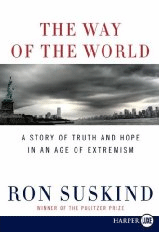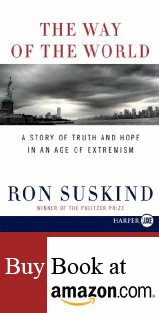 Author: Bush knew Iraq had no WMD
Author: Bush knew Iraq had no WMD
Journalist Ron Suskind says Bush ordered forgery linking Saddam, al-Qaeda
President Bush committed an impeachable offense by ordering the CIA to to manufacture a false pretense for the Iraq war in the form of a backdated, handwritten document linking Saddam Hussein and al-Qaeda, an explosive new book claims.
The charge is made in “The Way of the World: A Story of Truth and Hope in an Age of Extremism” by Pulitzer Prize-winning journalist Ron Suskind, released today.
Suskind says he spoke on the record with U.S. intelligence officials who stated that Bush was informed unequivocally in January 2003 that Saddam had no weapons of mass destruction. Nonetheless, his book relates, Bush decided to invade Iraq three months later — with the forged letter from the head of Iraqi intelligence to Saddam bolstering the U.S. rationale to go into war.
“It was a dark day for the CIA,” Suskind told TODAY co-host Meredith Vieira on Tuesday. “It was the kind of thing where [the CIA] said, ‘Look, this is not our charge. We’re not here to carry forth a political mandate — which is clearly what this was — to solve a political problem in America.’ And it was a cause of great grievance inside of the agency.”
 The author writes that Bush’s action is “one of the greatest lies in modern American political history” and suggests it is a crime of greater impact than Watergate. But the White House is denying the allegations, calling the book “absurd” and charging that Suskind practices “gutter journalism.”
The author writes that Bush’s action is “one of the greatest lies in modern American political history” and suggests it is a crime of greater impact than Watergate. But the White House is denying the allegations, calling the book “absurd” and charging that Suskind practices “gutter journalism.”
Former CIA director George Tenet also released a statement in which he ridicules the credibility of Suskind’s sources and calls the White House’s supposed directive to forge the document as “a complete fabrication.”
But Suskind stands by his work. “It’s not off the record,” he says. “It’s on the record. It’s in the book and people can read it for themselves.”
Prelude to war
Suskind reports that the head of Iraqi intelligence, Tahir Jalil Habbush, met secretly with British intelligence in Jordan in the early days of 2003. In weekly meetings with Michael Shipster, the British director of Iraqi operations, Habbush conveyed that Iraq had no active nuclear, chemical or biological weapons programs and no stockpiles of weapons of mass destruction.
When Tenet was informed of the findings in early February, he said, “They’re not going to like this downtown,” Suskind wrote, meaning the White House. Suskind says that Bush’s reaction to the report was: “Why don’t they ask him to give us something we can use to help make our case?”
Suskind quotes Rob Richer, the CIA’s Near East division head, as saying that the White House simply ignored the Habbush report and informed British intelligence that they no longer wanted Habbush as an informant.
“Bush wanted to go to war in Iraq from the very first days he was in office. Nothing was going to stop that,” Richer is quoted in the book.
Suskind also writes that Habbush was “resettled” in Jordan with help from the CIA and was paid $5 million in hush money.
Vieira questioned Suskind’s contentions, pointing out that a number of intelligence figures eventually wrote Habbush off as unreliable.
“No, that’s not exactly the way it worked,” Suskind countered. “In the book, you’ll see people who are involved and talking about the debate, and it was quite a fierce debate at the highest levels of the government: ‘Is Habbush reliable? What’s he saying? How can we check it?’
“And a lot of people, at the end of the day, said it was hard for him to prove the negative, that what he said was no weapons were actually not there. That’s hard to do.”
The letter
On page 371 of “The Way of the World,” Suskind describes the White House’s concoction of a forged letter purportedly from the hand of Habbush to Saddam Hussein to justify the United States’ decision to go to war.
Suskind writes: “The White House had concocted a fake letter from Habbush to Saddam, backdated to July 1, 2001. It said that 9/11 ringleader Mohammed Atta had actually trained for his mission in Iraq — thus showing, finally, that there was an operation link between Saddam and al-Qaeda, something the Vice President’s office had been pressing CIA to prove since 9/11 as a justification to invade.”
He continues: “A handwritten letter, with Habbush’s name on it, would be fashioned by CIA and then hand-carried by a CIA agent to Baghdad for dissemination.”
CIA officers Richer and John Maguire, who oversaw the Iraq Operations Group, are both on the record in Suskind’s book confirming the existence of the fake Habbush letter.
When asked by Vieira for further proof of the letter, Suskind said: “Well, the CIA folks involved in the book and others talk about George Tenet coming back from the White House with the assignment on White House stationery, and turning to the CIA operatives, who are professionals, and saying, ‘You may not like this, but here is our next mission.’
“And they carried it through step by step, all the way to the finish.”
The London Sunday Telegraph first published a story about the letter in December 2003, on the same day that Saddam Hussein was captured in Iraq. Reported as genuine, the letter made an immediate impact upon the media in terms of justifying the U.S.-led invasion of Iraq. Suskind relates how NBC reported the letter, with journalist Con Coughlin telling Tom Brokaw that the letter “is really concrete proof that al-Qaeda was working with Saddam.”
Suskind also quotes Alan Foley, head of WMD analysis for the CIA, as saying, “It is, in my opinion, true that the administration, for whatever reason, was determined to have a showdown with Iraq that predated this whole WMD stuff.”
In support of that theory, Foley says that Naji Sabri, Saddam’s foreign minister, passed along information that Iraq had no WMD to a Lebanese journalist who served as an intermediary on behalf of the CIA in 2002.
That intelligence, Suskind writes, was dismissed as “disinformation.”
Suskind’s credentials
So why, Vieira asked, are Suskind’s sources finally speaking out now, more than five years after the war began?
“Well, you know, a lot of them have been walking around with this lump in their chest for a couple of years — five years now,” Suskind replied. “And because they’re essentially free — they’re not the original source — they said, ‘Look, why hide now? Let’s trust the truth.’ ”
Suskind said it took about seven months to get his storied “nailed.” “I’d done this sort of thing for a while, and the way it worked was there were off-the-record sources who played out the story, and then I went to people actually involved,” he told Vieira.
“They were freed up because they’re not the original source, if you will … to sort of talk about the context, what they felt, what they did [and] the people actually involved. And of course they’re all, through the book, on the record talking about how it all worked.”
Suskind, who reported for The Wall Street Journal from 1993 to 2000, won a Pulitzer Prize for feature writing in 1995 for stories of inner-city honors students in Washington, D.C. His reports spawned book-club favorite “A Hope in the Unseen: An American Odyssey from the Inner City to the Ivy League” in 1998.
Two stories Suskind wrote for Esquire in 2002 gave readers an inside account of the Bush White House. The second, which ran in the December 2002 issue, raised eyebrows as John DiIulio, the former head of the White House Office of Faith-based and Community Initiatives, described a presidency driven by politics over policy — “the reign of the Mayberry Machiavellis.”
“The Price of Loyalty,” Suskind’s 2004 book on former U.S. Secretary of the Treasury Paul O’Neill, said that the U.S. occupation of Iraq and subsequent overthrow of Saddam Hussein were planned in January 2001 — nine months before the Sept. 11 attacks.
His most recent book, 2006’s “The One Percent Doctrine,” also described the Bush administration’s willingness to let its post-Sept. 11 foreign policy be driven by suspicion over proof of weapons of mass destruction. It also claimed al-Qaeda leaders were plotting to attack the New York City subway system in 2003.
In “The Way of the World,” Suskind describes President Bush as “a guy who needs to make things personal” and someone who “doesn’t think in large strategic terms.” He also says the president has “always been a bit of a bully.”
HarperCollins Publishers is printing 500,000 copies of the book and HCP executive editor Tim Duggan was quoted in Monday’s Wall Street Journal as saying Suskind “wrote it as fast as possible and we’re publishing it as fast as possible because there is news in the book and we don’t want to sit on it.”
ATTENTION READERS
We See The World From All Sides and Want YOU To Be Fully InformedIn fact, intentional disinformation is a disgraceful scourge in media today. So to assuage any possible errant incorrect information posted herein, we strongly encourage you to seek corroboration from other non-VT sources before forming an educated opinion.
About VT - Policies & Disclosures - Comment Policy



